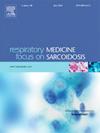慢性阻塞性肺病患者急性烟草暴露与呼出一氧化氮分数之间的关系:2007-2012年全国健康与营养调查(NHANES)。
IF 3.5
3区 医学
Q2 CARDIAC & CARDIOVASCULAR SYSTEMS
引用次数: 0
摘要
背景:分量呼出一氧化氮(FeNO)是 2 型气道炎症的标志物。烟草暴露可降低一氧化氮水平。然而,慢性阻塞性肺病(COPD)患者急性烟草暴露对一氧化氮的影响尚不清楚。本研究旨在探讨慢性阻塞性肺病患者急性烟草暴露与 FeNO 和嗜酸性粒细胞的关系:这项回顾性队列研究纳入了 445 名慢性阻塞性肺病患者,这些患者均来自 2007-2012 年美国国家健康与营养调查(National Health and Nutrition Examination Survey)。通过检测血清可替宁水平来评估环境烟草烟雾暴露。根据可替宁水平将患者分为五组:Q1(第一五分位数)、Q2(第二五分位数)、Q3(第三五分位数)、Q4(第四五分位数)和 Q5(第五五分位数)。采用逻辑回归模型和线性逻辑回归模型评估血清可替宁与 FeNO 和 EOS 水平之间的关系:结果:约有 16.5%(75/445)的参与者出现 FeNO 升高(>25 bbp)。在未经调整的模型中,血清可替宁水平最低五分位数(0.011-0.0185 纳克/毫升)的慢性阻塞性肺病患者的 FeNO 水平高于血清可替宁水平最高五分位数(≥309 纳克/毫升)的患者(几率比(OR),5.86 [2.11-16.20])。即使在调整了人口统计学、生活方式、糖尿病、冠心病、肿瘤、高血压、2 天内使用口服或吸入类固醇、哮喘和 7 天内出现呼吸道症状等协变量后,这些结果仍保持一致。此外,经 ln 转化的可替宁水平的标准差增加与 FeNO 水平的降低有关(OR,0.45 [0.33, 0.60])。在烟草烟碱和血液嗜酸性粒细胞之间没有观察到明显的相关性。在大量接触烟草后,也未发现 FeNO 与嗜酸性粒细胞之间存在相关性。我们的研究结果表明,可替宁水平高与慢性阻塞性肺病患者的血清嗜酸性粒细胞减少有关,但与血清嗜酸性粒细胞无关。这表明吸烟可能会影响慢性阻塞性肺病患者的 FeNO 水平,但似乎不会影响血液中的嗜酸性粒细胞水平。本文章由计算机程序翻译,如有差异,请以英文原文为准。
Association between acute tobacco exposure and fractional exhaled nitric oxide in patients with chronic obstructive pulmonary disease: National health and Nutrition Examination Survey (NHANES) 2007–2012
Background
Fractional exhaled nitric oxide (FeNO) is a marker of type 2 airway inflammation. Tobacco exposure can lower FeNO levels. However, the effect of acute tobacco exposure on FeNO in patients with chronic obstructive pulmonary disease (COPD) is unclear. This study aimed to investigate the relationship of acute tobacco exposure with FeNO and eosinophils in COPD patients.
Methods
This retrospective cohort study included 445 patients with COPD based on the 2007–2012 National Health and Nutrition Examination Survey. Serum cotinine levels were examined to assess environmental tobacco smoke exposure. The patients were divided into five groups based on cotinine levels: Q1 (first quintile), Q2 (second quintile), Q3 (third quintile), Q4 (fourth quintile) and Q5 (fifth quintile). Logistic regression models and linear logistic regression models were used to evaluate the relationship between serum cotinine and FeNO and EOS levels.
Results
Approximately 16.5 % (75/445) of the participants had elevated FeNO (>25 bbp). In the unadjusted model, COPD patients with the lowest quintile of serum cotinine levels (0.011–0.0185 ng/mL) had higher FeNO levels compared to those with the highest quintile (≥309 ng/mL) (odds ratios (OR), 5.86 [2.11–16.20]). These findings remained consistent even after adjusting for covariates of demographics, lifestyle, diabetes, coronary heart disease, tumours, hypertension, using oral or inhaled steroids within 2 days, asthma and respiratory symptoms within 7 days. Furthermore, a standard deviation increase of ln-transformed cotinine levels was associated with decreased FeNO levels (OR, 0.45 [0.33, 0.60]). No significant correlation was observed betweenserum cotinine and blood eosinophils. After high extents of tobacco exposure, no correlation was found between FeNO and eosinophils.
Our findings indicate that high cotinine levels are associated with decreased FeNO in COPD patients but not with blood eosinophils. This reveals that smoking may affect FeNO levels in patients with COPD, whereas it does not appear to influence blood eosinophil levels.
求助全文
通过发布文献求助,成功后即可免费获取论文全文。
去求助
来源期刊

Respiratory medicine
医学-呼吸系统
CiteScore
7.50
自引率
0.00%
发文量
199
审稿时长
38 days
期刊介绍:
Respiratory Medicine is an internationally-renowned journal devoted to the rapid publication of clinically-relevant respiratory medicine research. It combines cutting-edge original research with state-of-the-art reviews dealing with all aspects of respiratory diseases and therapeutic interventions. Topics include adult and paediatric medicine, epidemiology, immunology and cell biology, physiology, occupational disorders, and the role of allergens and pollutants.
Respiratory Medicine is increasingly the journal of choice for publication of phased trial work, commenting on effectiveness, dosage and methods of action.
 求助内容:
求助内容: 应助结果提醒方式:
应助结果提醒方式:


